18 Oct 2024
Updated on January 30th, 2025
Why Your Business Needs Manufacturing Inventory Management Software for Growth?
Matthew Connor
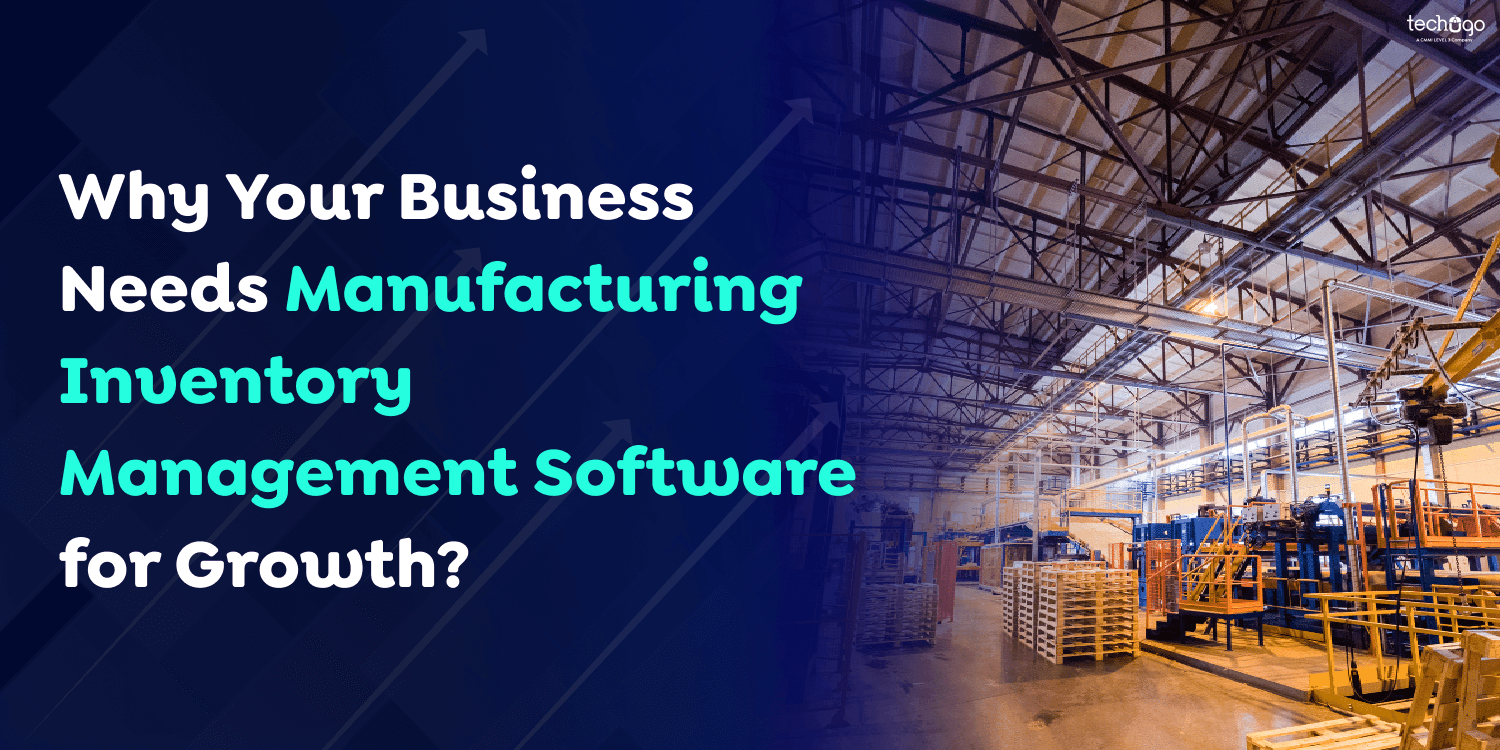
In today’s ever-changing manufacturing environment, managing and tracking inventory is a major problem. The old-fashioned method often leads to stock depletion, production issues, and more expensive expenses. This can slow down production, irritate customers, and lower the bottom line. Investing in the latest manufacturing inventory management software is a game changer.
It’s similar to upgrading from a map printed on paper to a GPS for your inventory. It has real-time tracking, automated ordering, and intelligent information insights; this program improves efficiency, saves money, and allows you to deliver orders to your customers in time. This is a crucial element for growth in the manufacturing sector. Even though developing and integrating this program may seem costly initially, the potential advantages far exceed the initial cost. Imagine it as an investment into the growth of your company.
You may wonder what it will cost to create a new system if you are looking to manufacture inventory management software that suits your business. The cost of developing custom inventory management software will be determined by a range of different variables. But do not fret—in this article, we will examine the cost of developing manufacturing inventory management software.
So, let’s get started.
What Is Manufacturing Inventory Management Software?
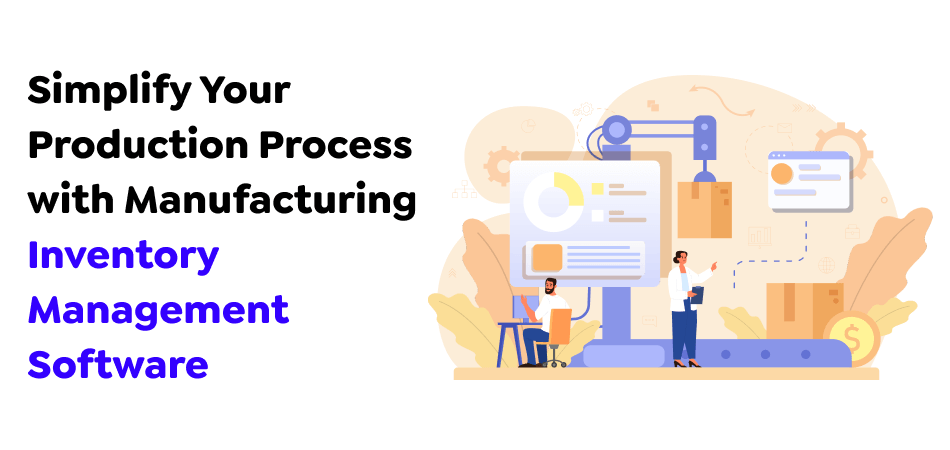
The core of manufacturing inventory software functions as the digital command center for controlling inventory. It’s an extensive system designed to keep track of, monitor, and improve inventory levels through all stages of manufacturing. From when raw products arrive at your factory until when you dispatch final products, this software meticulously documents every step to ensure that you are stocked with the correct materials in the proper amounts at the right moment.
Automating the processes of allocating materials and sourcing software for managing inventory reduces mistakes and improves efficiency. It prevents the costly practice of stocking too much to minimize uncertainty. This is done by offering important information on inventory levels and locations.
In addition, you can be sure that all inventory levels are thoroughly monitored, which reduces the risk of shortages, which can cause delays or insufficient delivery to clients. Effective inventory management enhances customer service reliability and makes the best possible use of the resources at hand.
Types Of Manufacturing Inventory Management Software
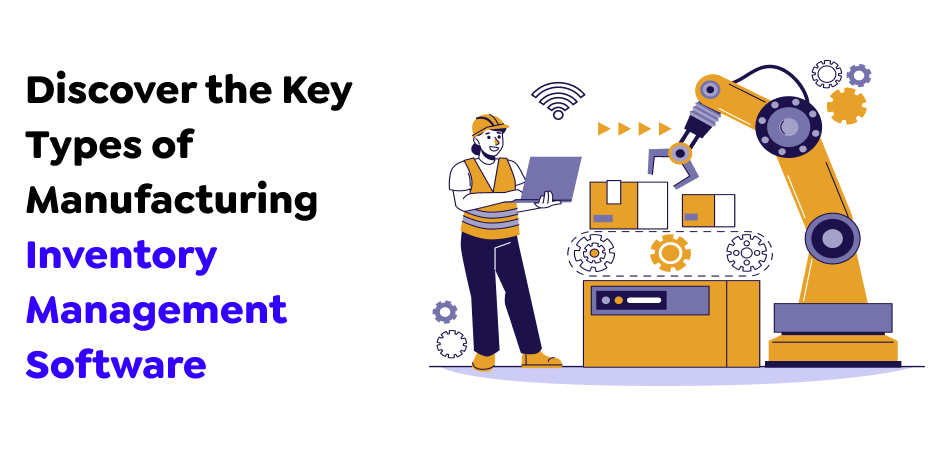
There are many types of Manufacturing Inventory Management Software in the marketplace. They include:
1. Enterprise Resource Planning Systems
ERP software integrates business functions, including financial management, production schedule, and stock management. It provides a complete strategy for managing manufacturing operations, ensuring smooth cooperation between departments and efficient data circulation.
ERP software improves decision-making processes, optimizes resource allocation, and improves efficiency by centralizing information. This reduces cost and increases efficiency. The expense of constructing ERP software may vary from $30,000 to a couple of million dollars. This is influenced by several variables, such as customizations and the selection of modules
2. Warehouse Management Systems
The main purpose of WMS products is to optimize warehouse operations like stock tracking, storage transportation, and picking. They facilitate efficient warehouse management by providing manufacturers with access to real-time information about stock movements and levels.
Solutions for WMS reduce operating expenses, improve order accuracy, and increase overall warehouse efficiency through automation and streamlined processes. The development of a warehouse management system costs $50 to $250,000. It is influenced by variables like the size of your warehouse, its real-time tracking capability, the integration of ERP and SCM systems, and the automated level.
3. Material Requirements Planning Systems
MRP Systems regulate manufacturing by ensuring that products are in stock for shipment and the raw materials are ready for production. Based on projections of sales and production plans, they assist with the scheduling of purchases, manufacturing tasks, and delivery dates. The MRP system ensures the correct availability of supplies to increase the amount of inventory, minimize wasted materials, and assure efficiency in production.
The material requirements planning systems typically range from $4,000 to $250,000, depending on factors like the difficulty of manufacturing processes, their integration with ERP systems, demand forecasting accuracy, and scalability.
4. Point-Of-Sale (PoS) Systems
POS software continuously monitors inventory levels and sales while directing retail store inventory. The PoS software helps manage consumer orders, facilitates transactions, and provides inventory turnover and sales data.
Development costs usually range from $50,000 to $150,000. The amount is determined by factors such as real-time data processing, integration with systems for inventory control, the number of sales points, and CRM functions.
5. Inventory Control Systems
Inventory management software keeps track of inventory and stock levels and ensures the inventory is utilized efficiently. The systems provide features that track inventory turnover, restock supplies, and maintain a close eye on inventory levels. Control systems for inventory help maintain inventory levels, reduce costs, and keep track of product supply. They can prevent excess stock and ensure that products are always available.
6. Production Management Software
The manufacturers can manage, plan, and schedule control their processes through the aid of production management software. The features offered include shop floor management, work order management, and production scheduling. Inventory management software allows companies to use their resources efficiently.
Additionally, it helps reduce the time spent between maintenance and assures consistent product quality. It accomplishes this by ensuring manufacturing processes work and conforms to high standards of quality.
7. Supply Chain Management Software
Supply Chain Management (SCM) software manages the purchasing of raw materials, goods, and delivery. Tools for managing inventory help companies coordinate logistics, collaborate with suppliers, and improve the circulation of materials and goods in the supply chain. These functions help manage logistics effectively and assist when working with suppliers.
In addition, they help improve the flow of goods and supplies in the supply chain. Software for managing supply chains helps to make the supply chain more efficient. It achieves this through improving transparency, encouraging collaboration, and decreasing lead times. The expense of SCM software development generally ranges from $30,000 to $250,000 or higher, depending on the complexity of the supply chain process, integration with existing systems, real-time data analytics, and the degree of automation.
Advantages Of Manufacturing Inventory Management Software Development
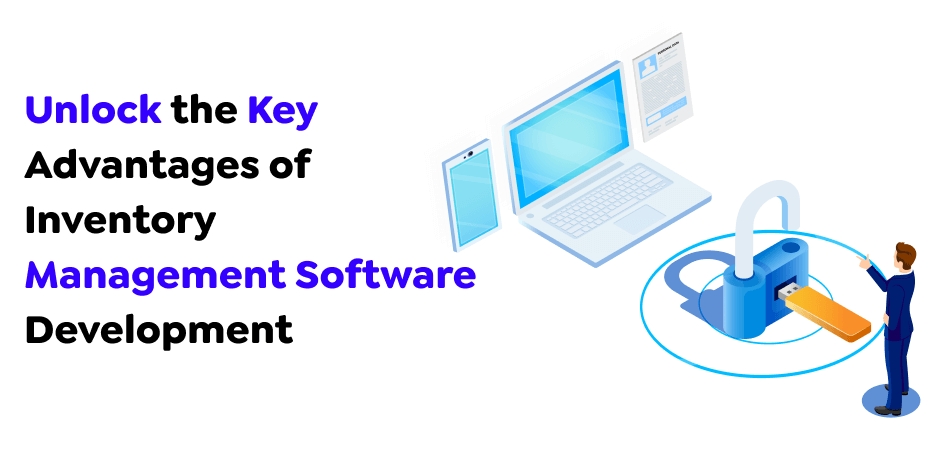
In this section, we will explain how creating manufacturing inventory management software will benefit your business.
1. Centralized Storage
If your products are located in multiple locations, it becomes difficult to organize orders and get the correct products to the most appropriate clients. Well-designed warehouse software helps you keep track of the inventory of various products and inform customers of the progress of their orders.
2. Well-Organized Stock Operations
The software can help users keep track of inventory items. It saves time and energy since you don’t have to hurry to the warehouse to determine whether a product is available when demand arises.
3. Improves Sales Productivity
Keep track of your inventory. You will retain customers and reduce the chances of committing common mistakes in human reporting, including inaccurate counts of items. In addition, you can easily adhere to delivery timeframes using an inventory management system. Customers do not need to wait long until their package arrives. It is easy to track the items and be aware of the precise date when the item will arrive.
4. Satisfied Customers
Your customers will surely be satisfied if you provide timely, precise responses, shipping, and customized solutions. They’ll be able to monitor the progress of their delivery and avoid the possibility of receiving a late notice about product inaccessibility.
5. Adjusted Order Frequency
If stock shortages can be detrimental to your business and overstocking can be even worse, it’s the same for your business. By using good inventory management software, you can track your stock levels and replenish them as needed. This will reduce the waste of items, which can result in a massive loss of money.
6. Increases Productivity
By keeping a full record of everything, you’ll be able to avoid losing customers and lower your risk of making a mistake. Human errors in detail are quite typical, including not properly marking things. Additionally, with the help of inventory management software, businesses can meet delivery deadlines. Customers will not need to wait long to receive their package.
7. Monitoring Regular Orders
If the company’s lack of stock is a problem, overstocking can be more damaging. With a well-organized inventory system, you can monitor and request the actual inventory levels anytime. This will eliminate the disuse of goods, which results in enormous money losses.
Cost Of Developing Manufacturing Inventory Management Software

The expense of developing inventory management software largely depends on the various aspects and functions it integrates. Therefore, it is crucial to have a fundamental understanding of business requirements.
Suppose you demonstrate the basics of understanding what a business requires. In that case, you can determine whether you can earn a profit with a simple introductory method or require an entire functional inventory management software that integrates with ERP software. Furthermore, the knowledge gained can assist in setting the proper budget.
If you’re willing to build an inventory management program starting from scratch, the expense could be between $15000 and $250000. It is entirely contingent on the various technologies, features, and functions included in the program.
Factors Affecting The Cost Of Inventory Management Software Development
Developing manufacturing inventory management software is a smart move that any company can take to enhance operations and improve productivity. However, knowing the elements that affect the expense of production inventory management software undertaking is essential for efficient budgeting and arranging. We’ll explore the details which determine the cost of this revolutionary technology:
1. Scope And Complexity Of Features
The foundation of cost estimation is the range and depth of features you plan to include in the software. The basics, like barcode scanning, inventory tracking, and reorder notifications, form the basis when you add layers of complexity, such as real-time demand forecasting and multi-location management interfacing with different platforms, and the development time and cost increase.
2. Customization Is Different From Off-The-Shelf Solutions
An important consideration is choosing a custom solution tailored to your needs or opting for an already-built on-the-shelf application. Custom-built flexible solutions offer unbeatable flexibility and an ideal fit to your specific workflow.
However, they cost more due to the extensive design and customization required. The off-the-shelf alternatives are typically cheaper, but they may need compromises regarding the features offered and their adaptability.
3. Development Team Expertise And Location
The experience of your software development company and their geographical place of work also play a role. Highly skilled developers can command more; their skills translate into quicker development times and better code. Location plays a part, too, with the developers of certain regions having various pricing structures.
4. Scalability Conditions
The requirement for flexible solutions that can grow with the enterprise greatly impacts the expense of developing inventory software designed for industrial use. Systems that can scale require robust designs and architecture, which will increase the initial price but also ensure flexibility and efficiency for the future. Planning for scalability impacts the development cost of manufacturing inventory systems by predicting scenarios for peak demand and ensuring the system can cope with an increased volume of transactions without losing efficiency.
5. Technology Stack And Platforms
The technology that underlies your software has a large impact on the cost estimation. The choices of programming languages, frameworks, databases, and cloud infrastructure affect the time required to develop your software, its complexity, and resource demands. Furthermore, when you’re targeting different platforms (web, mobile, desktop), the development effort will increase, which can impact your overall costs.
6. Integration Into Existing Systems
If your company’s manufacturing operation has various systems in place, such as ERP, CRM, and accounting systems, then integrating the latest inventory management software is essential. The difficulty of these integrations, data transfer, and ensuring a seamless flow of data can affect the timeline for development and costs.
7. Design And User Experience (UX)
The design and user-friendliness of your software interface shouldn’t be undervalued. Investing in a user-friendly interface and an easy User Experience (UX) may result in additional expenses initially but payoffs concerning user acceptance efficiency, productivity, and overall satisfaction.
8. Testing And Quality Assurance
Rigid testing ensures your software runs smoothly and offers a flawless user experience. Allocating resources to thorough testing, bug-fixing, and quality control is crucial, as it affects the timeline of your project and its budget.
9. Deployment And Infrastructure
The choice of deploying on-premises and cloud-based options affects the cost. On-premise options require the investment of servers, hardware, and even maintenance. Cloud-based alternatives typically have subscription costs but ease the strain of managing infrastructure.
10. Training And Support
Ensuring your staff is trained to use the software and offering ongoing support is essential for a successful rollout. The cost of training material sessions, training, and other assistance resources can add to the total cost.
11. Post Launch Maintenance And Upgrades
Software development is a continual process. Planned maintenance for regular upgrades, bug fixes, and potential enhancements to features will ensure that your software is pertinent and meets customers’ changing needs.
Must-Have Features Of Manufacturing Inventory Management Software
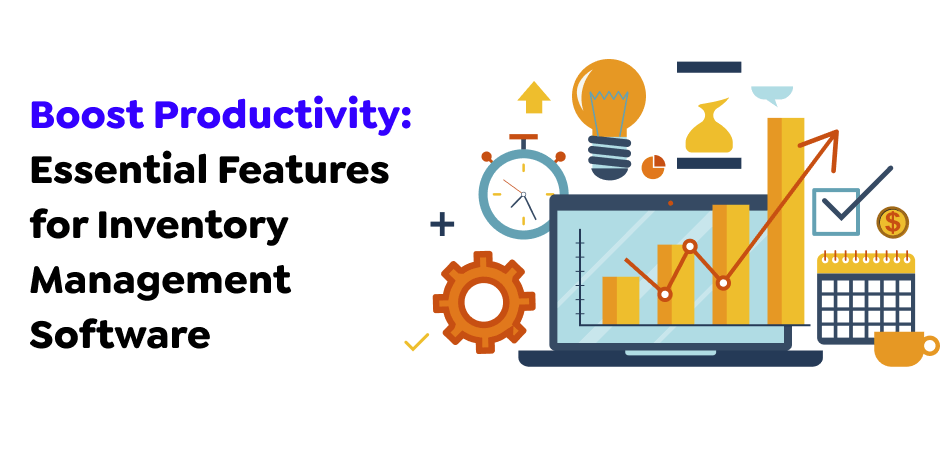
This section will look at useful features to incorporate into the inventory management software development procedure. We’ll cover the most common features of manufacturing inventory management software. Suppose you contact the developers of your inventory management system team. In that case, the very first thing they will ask is about the features you wish to integrate into the software. There may be a variety of things that you would like to include in your system. Many of the most popular features can be found here.
1. Product Listing
This option simplifies and manages your inventory using details like price availability, liability, and SKUs. It also enables you to design options for each product by analyzing its essential characteristics and organizing the items.
2. Real-Time Inventory Tracking
Companies can track their inventory levels in real-time using continuously updated data. The data contains information about inventory quantities, locations, and movements. In addition, businesses can monitor their inventory at a real-time rate.
This feature prevents overstock and stockouts by ensuring the inventory information is accurate at every moment. The availability of current inventory information allows companies to make quick choices when supply chain issues arise, improving the efficiency of inventory management.
3. Barcode Scanning
Inventory management and tracking have improved accessibility and speed by using barcode scanners. This reduces the chance of errors and dramatically accelerates the inventory process by removing the necessity to enter data manually.
Scanning barcodes when receiving, moving, and shipping products ensures precise and prompt documentation of all inventory activities. It helps improve inventory control and decreases the cost of labor as it improves operational efficiency and data accuracy.
4. Order Processing
Features for order management make production, tracking, and even fulfillment much easier. It ensures it can process orders swiftly and accurately by automating the process, reducing wait time, and minimizing the chance of making errors.
Increased customer satisfaction and shorter time to deliver results from efficient administration of orders. This software helps keep track of orders, monitor reserves, provide information to customers, and improve the overall customer experience in general.
5. Analytics And Reporting
Tools for complete monitoring and analysis give you full knowledge of the performance of your inventory and the trends. This helps you make informed choices; companies can offer precise information on the state of their stock, sales trends, reordering points, and many more. These data can help identify patterns, forecast demand, and manage inventory levels. There are many ways to identify mistakes. Examine the performance of key performance indicators (KPIs) and develop strategies to improve stock management using extensive data analysis.
6. Integration With Other Systems
Integration with different business software systems, such as accounting, ERP, and eCommerce platforms, ensures seamless data exchange between various departments. This improves efficiency by eliminating barriers to data and facilitating the exchange of information across multiple functions.
Integrated systems provide a single view of operations, which makes management more effective and coordinated. It results in improved financial monitoring, more effective processes, and a better approach to corporate governance.
7. Multi-Site Administration
Software for managing inventory offers robust multi-location management options for businesses with multiple locations. This tool helps manage and track inventory across various locations to ensure optimal stock levels globally. It can help reduce surplus inventory, maintain inventory balance, and avoid shortages.
Central management also allows analysis and reporting to be more easily accessible to companies, allowing them to ensure efficiency and consistency across multiple sites. It enhances the overall performance of their operations.
How To Choose The Best Inventory Management Software For Your Business?
Finding the best manufacturing inventory management software can be difficult. These are the most important factors to consider when choosing the right inventory management program for your business.
1. Timing
It’s a key element to an organization’s overall success. If you spend excessive time organizing your company’s inventory, you can be a stumbling block. Moving to an automated system instead of traditional Inventory tracking devices will allow you to avoid overselling, reduce inventory mistakes, and also save you less time at manual operating stations.
2. Features
It is essential to list the attributes you would like to see in your inventory management software. You should also choose a software that can use new technologies to improve your workflow for inventory and other business processes. It is recommended to go for an application that can include additional features.
3. Integrations
Integrations from third-party companies play a crucial role in the increasing popularity of inventory management. Make sure you list the most crucial integrations, such as payments, shipping, POI 3PL commerce platform, and so on. Your application must connect directly with the other tools, or it is necessary to use APIs for similar purposes.
4. Usability
It’s essential to have programs that can be used by novices and experts equally. They must be simple to master and easy to use, and their UX/UI should be intuitive. Usability is an essential aspect and should not be ignored at any price.
5. Development
A solution for managing inventory is a crucial part of business. Therefore, it is crucial to select software powered by innovation and with the latest technology. The software must be upgraded often, and any bugs or issues must be addressed regularly.
6. Support
More than a simple inventory software purchase is required, as there are many technological issues later. To address these issues, choose an inventory software provider that offers regular maintenance and technical support. Ensure you know if you receive phone support or only limited assistance. Additionally, you must understand the rating and quality of support services.
Future Trends In Inventory Management Software
In this section, we will look at the key trends in manufacturing inventory management software development.
1. Artificial Intelligence And Machine Learning
AI and ML have revolutionized inventory management by allowing businesses to forecast demands, utilize analytics, and automate decision-making. AI algorithms use data from the past to predict future inventory needs, ensuring optimal inventory levels.
ML models increase efficiency over time by constantly developing patterns in data. They enhance the efficiency of inventory processes through automation of repetitive processes and reduce the chance of human error. Businesses can utilize AI or ML to decrease the number of products in stock, monitor changes in demand, and make data-driven decisions.
2. Cloud-Based Solutions
The cloud-based inventory management software lets businesses scale up and grow. With the help of technology, companies can work remotely and monitor their inventory by using information from inventory at any moment. Cloud platforms are able to provide immediate updates to make sure that each user has access to the most current details.
Cloud-based solutions enable businesses to expand with minimal investment in the IT infrastructure. Because of their versatility cloud-based solutions work well for businesses that want to develop several locations.
3. Internet Of Things
The process of tracking inventory is changing with technology like the Internet of Things, which utilizes RFID tags and sensors. These devices provide instantaneous information regarding inventory levels, activities, and conditions. IoT-enabled devices improve inventory visibility and management, allowing businesses to keep monitor their inventory and make smarter decisions on the go.
Smart sensors can alert managers of temperature drops and how they can affect perishable goods. IoT technology integration boosts inventory accuracy, reduces loss, and streamlines the supply chain process.
4. Blockchain Technology
Blockchain technology provides an unalterable and continuous record of transactions increasing transparency and security when controlling the inventory. Anyone who can access the blockchain ledger records every movement of inventory. It is therefore much more protected from fraudulent illegal, incorrect, or fraudulent changes. Blockchain guarantees complete transparency and transparency.
Blockchain technology can identify where goods are sourced and from where they travel making sure that there is the integrity of your supply chain. Companies can improve the security of their supply chain by making use of blockchain technology to increase trust and confidence when managing their stocks.
Conclusion
In the current, ever-changing world of manufacturing, where inventory management is a challenge, inadequate inventory control still needs to be improved. So, investing in the latest manufacturing inventory software is vital. We hope you are aware of the average manufacturing inventory management cost through this blog. Now, you have the information needed to grasp pricing systems and the possibility of unexpected expenses, and finally, pick a plan that can help strengthen your business without costing you a fortune.
Remember that a “right” price is a balance between your requirements and the price the market is willing to pay rather than a set sum. Take advantage of the exploration process; don’t be afraid to ask questions. Consider value over seeking out the best bargain. Partnering with Techugo, a leading software app development company, can help you access the most cutting-edge solutions tailored to your needs. Techugo ensures that you get a custom, user-friendly manufacturing inventory management system that enhances operational efficiency and drives business growth.
Get in touch with us today to learn how our manufacturing inventory management software can transform your operations and drive your business forward!
Get In touch
We are excited to here from you and let’s start something special Together. Call Us for any inquiry.
Write us
sales@techugo.caJust a call away
About you




